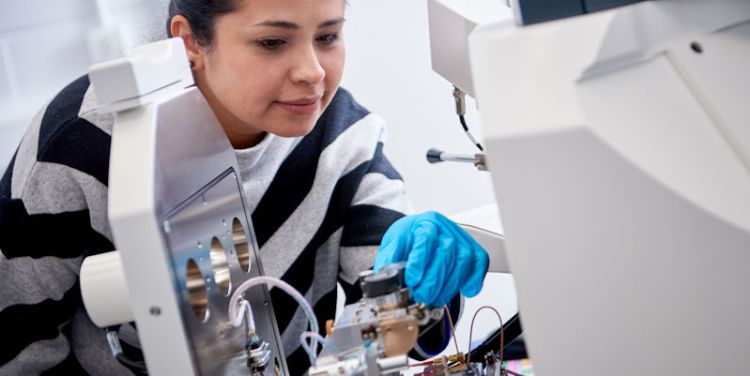Research spotlight: Making concrete greener
Concrete infrastructure is an ‘unsung hero’ our lives, forming the fabric of modern cities around the world.
Portland cement, widely used to bind concrete, currently accounts for 8% of global CO2 emissions due to the large volume being produced, researchers say. This is expected to rise to as much as 25% over the next decade, so there is a need to engineer new solutions which can mitigate its environmental footprint.
EPSRC Early Career Fellow Professor Susan Bernal Lopez and her team at the University of Leeds are developing and studying low-carbon cements. Their aim is to develop sustainable cement alternatives which can be produced from wastes or by-products from different industrial, mining or agricultural processes.
If successful, this could reduce the CO2 emissions associated with the infrastructure sector and turn waste products into valuable resources.
Some of these wastes have no current commercial value but are widely available throughout the world, particularly in the Global South. If successful, this could reduce the CO2 emissions associated with the infrastructure sector and turn waste products into valuable resources.

Professor Susan Bernal Lopez and her team are developing and studying low-carbon cements.
Improving resilience
Concrete is a dynamic material: the cement gluing its components together undergoes chemical reactions spanning several decades. Part of Professor Bernal Lopez’s research investigates which chemical reactions and physical processes can cause cements to deteriorate, with the view of extending the life span of the concrete.
The interaction of CO2 with cements and its depletion of structural concrete’s longevity is a main focus. This is critical – CO2 concentrations in air are now at their highest in human history, posing a threat to the durability of modern concretes.The ultimate goal is to develop sustainable concretes with the ability to capture large amounts of CO2 without compromising their strength.
“Concrete is like a sponge on the nanoscale: anything which enters the material will alter it,” said Professor Bernal Lopez. “A key challenge to engineers is that, as a result of climate change, it is not possible to predict how fast the climate will transform. This makes it difficult to replicate environmental conditions to predict how the material will behave.”
A key challenge to engineers is that, as a result of climate change, it is not possible to predict how fast the climate will transform.
Specialist climate-controlled facilities at Leeds allow the researchers to simulate marine environments, and the extreme freeze-thaw action of very cold climates. Additionally, it will give insight into how the concretes perform to ensure they are safe for use.
Sharing expertise
Materials scientists, civil engineers, environmental scientists, chemists and architects are just part of the pool of experts working together to tackle the challenge of producing low-carbon cement, while maximising the durability of concrete and minimising CO2 emissions.
The strong interdisciplinary culture at the University of Leeds has enabled Professor Bernal Lopez, and team member Marie Curie Fellow Dr Juan Pablo Gevaudan, to work together with academic researchers from different disciplines to further innovation.
Corrosion experts Dr Richard Barker and Dr Adriana Matamoros-Veloza from the Institute of Functional Surfaces have collaborated with Professor Bernal Lopez’s team. Together they are working to shine a new light on how structural steels corrode when embedded in concretes that are produced with novel cements.
“Each involved, from materials scientists to engineers and chemists, has a vital role in bringing this leading research into fruition,” said Professor Bernal Lopez. “Our research spans a range of disciplines so the volume of its impact will be large.”
Leeds... is one of the unique Schools in the UK which studies materials from the micro- to the nano-scale with an interdisciplinary focus.
She continued: “Leeds is strong in that it is one of the unique Schools in the UK which studies materials from the micro- to the nano-scale with an interdisciplinary focus. It has electrochemistry and cement expertise and the potential to collaborate is vast, which is why I was drawn to it.”
She added: “Communicating across disciplines is vital, and the University of Leeds provides this platform.”
Opportunities for postgraduate researchers
Professor Bernal Lopez is also a researcher in the Bragg Centre for Materials Research and these facilities will be crucial to her team’s investigations.
Postgraduate researchers working with Professor Bernal Lopez use specialist facilities across campus, including those housed at the UKCRIC National Centre for Infrastructure Materials, and The Henry Royce Institute Facilities across the country.
Further information
Researchers in The UKRIC National Centre for Infrastructure Materials investigate the ageing and deterioration of infrastructure materials.
The Neville Centre is the first point of contact for industry and academia to drive innovation in cement and concrete.
The research is linked to Professor Professor Bernal Lopez EPSRC Early Career Fellowship, and a National Science Foundation (USA) EPSRC (UK) lead agency grant she was awarded in collaboration with the University of Sheffield, UK, and the University of Texas at Austin, USA.
Discover more about climate solutions at the University of Leeds.

